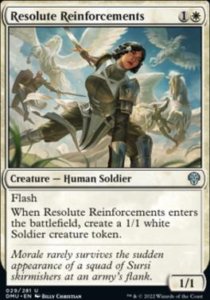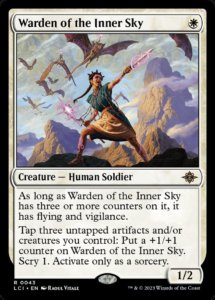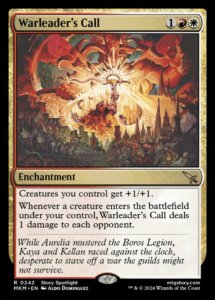Welcome to my Standard Convoke primer and sideboard guide. I hope you’ll find this article useful and that it’ll help you dominate your next tournament.
If you are new here, don’t forget to check our Discord Channel. it’s free for everyone!
Before I get into the deck itself, it’s important to point out the differences between this guide and the others posted on this website. If you’re a Mystical Teachings regular, you’ve probably already realised that we value quality over quantity. Our goal is to create high-level content filled with in-depth ideas that come from our experience as players. Writing this type of article takes time, and as long as it pertains to Modern or Pioneer, it’s not that big of an issue. But Standard changes so fast that creating evergreen written content is close to impossible. I’m also constantly testing, so my ideas can evolve over time. That’s why we’ve come to the conclusion that we need to adjust our model a bit to fit standard’s needs a bit better. Like always, I’ll write down my thoughts about the theory of how the deck works, what are the deckbuilding options, what are possible traps, etc. I’ll also talk shortly about the most played matchups. But instead of providing you with a Cheat Sheet, we’re gonna include a living Excel spreadsheet that’ll be updated week to week to best reflect my current list and sideboard plans. My notes will also touch mostly on the general approach you should take. They will also be updated once I find something new, so you can expect some editing here and there during this season.
Because of special circumstances (us writing this article live in Chicago) we are doing something different this time – the primer section of this article is free for all readers but the sideboard guide will be available for our Premium users. We are making considerable effort to race against the time in order to update you with all of our findings, hope you find them as useful as we do!
Introduction
Convoke is an aggro deck that tries to go as wide and as fast as possible. It’s capable of ending the game on turn four or presenting unbeatable openings after the first three, or even two, turns with Gleeful Demolition and Knight-Errant of Eos. The deck also has ways to create card advantage, either in the form of getting multiple creatures from one card or drawing extra cards thanks to Knight, Clues, and adventure cards.
The deck is quite similar to its Pioneer iteration – it uses Gleeful Demolition and other good token generators to enable Knight-Errant of Eos and Imodane’s Recruiter. The biggest differences are in the lack of Venerated Loxodon and a much worse manabase. Still, when the deck works, it feels like it shouldn’t be legal in Standard, which is the main draw to it.
The deck can be separated into three sections:
- Enablers
- Payoffs
- Others
Some of the cards can be challenging to categorise. For example, Evangelist both generates a token and pumps the team later on. I decided to do it because pointing out what’s enabler and what’s payoff helps with mulligan decisions and sideboarding.
My current decklist
If you don’t see it, or want to download the list, click here.
Maindeck
Enablers
To this section we’ll add basically any card that can create more than one game object. The goal is to flood the board and make opposing removal and blocks as ineffective as it could be.
The best one is Gleeful Demolition, as creating three bodies for just one mana is excellent. It leads to the best openings and if you can cast it on turn two, it’s almost always a keep. It also can destroy opposing artifacts. I don’t do this often, but keep this possibility in mind. Never cut it.
The duo of Voldaren Epicure and Novice Inspector is as important as Demolition. They may look not that impressive, but there are a lot of good interactions that make them essential for the deck:
- Blood and Clue tokens are the only targets for Gleeful Demolition.
- Having two game objects for one mana fuels Warden and Bunnicorn really fast.
- They offer card filtering or just outright extra cardboard. It’s also something to do if you have to keep the mana open.
Like Demolition, never cut them. They are the glue that holds the whole deck together.

Resolute Reinforcements
It’s considered the worst enabler. Creating two creatures out of one card for two mana may not sound that powerful, but it’s an important piece of the puzzle. In my opinion, it shows how good it is in postboard games when it prevents you from overextending into sorcery speed removal and sweepers.
Unlike the Demolition, Epicure, and Inspector, Reinforcements can be trimmed postboard. I usually tend to cut one, maybe two copies against End the Festivities, and when my other two drops are good.
Payoffs
Knight-Errant of Eos
It’s the best way to get ahead both on the tempo and card advantage. The ideal scenario is to cast it on turn two after you play Gleeful Demolition. If you don’t have the nuts or the opponent has some interaction, casting it on turn three or four is still perfectly doable. Resolved Knight is also a way to play around three mana sweepers, at least to some extent, as it survives all of them and finds you bodies to rebuild.
Remember about what you’re looking for with its trigger. Tapping five creatures is ideal since you’ll be able to chain Knights.Three is also an important number, since it lets you find Recruiter and Evangelist. Always play four, never cut them.
Imodane’s Recruiter
When I evaluate this card, I only think about the Recruiter half. While it has an adventure side, it rarely comes up, usually very late in the game when the board is cleared with a sweeper.
The card fits Convoke’s strategy perfectly. It makes the deck significantly faster and more powerful – both haste and the pump effect are often vital in mid and late game. When combined with Gleeful Demolition, it’s often the best way to finish the game after sweepers or when you’re ahead on board. With all that being said, I can see siding out one copy sometimes. I do this when the game leads to board stalls and the game is decided in one, huge swing. For example, in the mirror you need to make room for other cards and in some sideboard configurations, the fourth Recruiter may have to go.
Sanguine Evangelist
When I saw Evangelist in the first Convoke list I wanted to try out, I thought it was bad and started replacing it with other stuff. But eventually I went back to it and never looked back. It creates multiple game objects and pumps the whole team while attacking, so both effects we’re looking for. In my opinion, some people don’t value going wide enough and instead they opt for other three drops (Warleader’s Call comes to mind, but more on it later). Evangelist is three creatures packed into one card, so it’s a perfect tool for interactive matchups. Even if it rarely survives the first combat it engages, or gets tagged with removal, it still provides you with a good amount of value.
Other

Warden of the Inner Sky
Warden is a one drop that acts as a payoff in terms of using game objects that would otherwise be useless. If left unchecked, it easily dominates the game and kills very quickly. It also digs you for whatever you’re looking for.
When I was playing the card, I found a few play patterns that were common enough that I decided to write them down.
- If you have both Warden and Epicure/Inspector, lead with the one that generates a token, so you can get a Warden activation even in the face of removal.
- After you tap Warden, Epicure/Inspector and the token, you can follow it up with Gleeful Demolition and get another activation.
- Sometimes it’s better to grow it instead of pushing the damage through. The bigger it is, the fewer removal spells will be able to deal with it. Two counters is the key: it will make Warden immune to Cut Down, and three damage burn spells like Lightning Strike, Brotherhood’s End, etc. Also putting counters in the mirror makes it harder for the opponent to kill it with Case.
I can see cutting one copy of it against decks with Cut Down or a lot of mass removal – Warden takes time to show its potential and against for example UW Control, you won’t have time for tapping stuff.
Case of the Gateway Express
If you develop on schedule, Case kills basically anything on curve. It’s quite easy to kill creatures with high toughness that would otherwise be rather problematic. Once you deal with the blocker, it’s easy to solve it the very same turn. Note that you can cast the Case even if the opponent doesn’t have any creatures – do so if you value pump highly or the opponent doesn’t have any targets in the deck.
Even though Case can act as a pump spell, you should mainly consider it as a removal. It can be sided out quite often, for example against decks that don’t have any meaningful targets or when other sideboard cards look much more appealing.
Regal Bunnicorn
Bunnicon is the most high variance card in the deck. Sometimes it’s phenomenal, while in other situations it just trades with opposing removal. It all comes down to how often you want a two mana vanilla creature, even if it’s 5/5 or larger. The answer to this question isn’t easy and can change week to week. In my opinion, Regal Bunnicorn is the flex slot in the deck and usually it should be good enough to earn its spot. It’s quite easy to cast it on turn two as a 3/3 and a turn later attack for six or more damage. It often grows to more than ten power. Just because of the fact it alone creates a new axis of attack – going tall instead of going only wide – I often try to have it in my deck and I accept that it will be sided out a decent amount of times. Some of you would say that it’s bad against decks with black removal. In my opinion, the evaluation changes based on what the other colour offers. For example, RB or UB Midrange have on average four removal spells for it and it will cost at least two mana, so it’s even based on the mana spent. Deathtouch blockers (other creatures are too small to trade profitably) cost even more mana, so you should be happy with the outcome. But for example against BG with Glissa Sunslayer, Regal Bunnicorn can be a weakness. It has some serious downsides though. It matches up poorly against mass removal spells, especially cheaper ones like Temporary Lockdown or Path of Peril. Repeatable chump blockers, like tokens from Wedding Announcement, can also cause some issues.
Possible maindeckable cards that I’m not playing

Warleader’s Call
On paper, the anthem effect with ways to deal final points of damage should be decent in Convoke, but my testing convinced me otherwise. There are multiple reasons why I’m playing Evangelist in the three drop slot instead. The biggest problem is that Warleader’s Call doesn’t produce any form of pressure on its own. You also can’t find it with Knight-Errant, unlike Evangelist. Maybe without better alternatives, Warleader’s Call would be able to make the cut. But in my opinion both Evangelist and Bunnicorn are better for the deck. Maybe it could be good in the sideboard as a way to win board stalls, but right now I’m more interested in other cards.
Yotian Frontliner
Some lists opt for a couple copies of Yotian Frontliner to increase the artifact count for Gleeful Demolition. While I like this general concept, I don’t think that it’s enough to justify its inclusion. I would like to play more than eight enablers for Demolition, but not at all cost. We need to wait for either an Ornithopter or another Inspector. Maybe playing only one copy, so you’ll never draw two of them, can be the solution, but it looks too underpowered for me.
Witchstalker’s Frenzy
On paper, the card should fit well in a go-wide strategy, but I found out that it’s usually better to play more creatures than to kill the one the opponent has just cast. Unlike Case, Witchstalker’s Frenzy can’t upgrade your board in any way. I can see being played in the maindeck as a one- or two-of in more creature-centric metagames. And postboard you have access to removal that better suits any particular needs you might have.
The manabase
The deck’s biggest weakness is the manabase. There just aren’t enough good lands to make it smooth. Enemy colours don’t have access to fastlands, so we need to rely on Battlefield Forge, Thran Portal, Cavern of Souls, and a bunch of basics and channel lands. There’s also Sundown Pass, but it comes into play tapped fairly often, so it’s far from being ideal. I think that without Cavern, the mana would not be functional. Luckily for us, the deck plays only two tribes: Humans and Vampires (with a light Rabbit inclusion), so it lets us fix the mana to cast creatures. I like it so much that I even added Secluded Courtyard.
Sideboard options
The second biggest weakness of Convoke is its sideboard. There simply aren’t enough good, impactful cards that would also fit to the deck’s main gameplan. That’s why the sideboard is usually filled with generically good answers to the problems you might face.
Because Standard changes fast and local metagames can be very different from each other, I decided to write down pros and cons of all playable options. I also know that new cards will be added to combat new strategies, so I’ll do my best to update it when any changes happen.
Sideboarding in Convoke is relatively straightforward. The deck either wants to neutralise opponent’s hate cards or play removal spells to interact with the opponent’s gameplan. That’s why I separated sideboard options into three categories: removal spells, hate cards and others/traps.
The rest of this article is reserved for our Premium Users. Would you like to find out more? Please log in with your Premium account using the form below.
If you don't have a Premium account just yet, sign up here!
In the meantime, have a look at our selection of free articles and videos!
